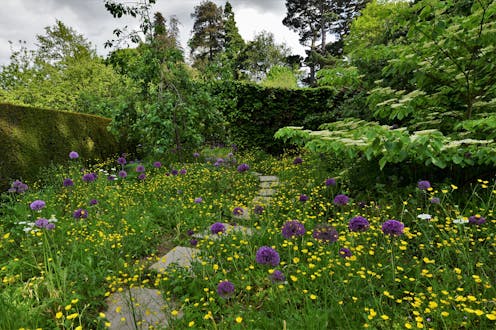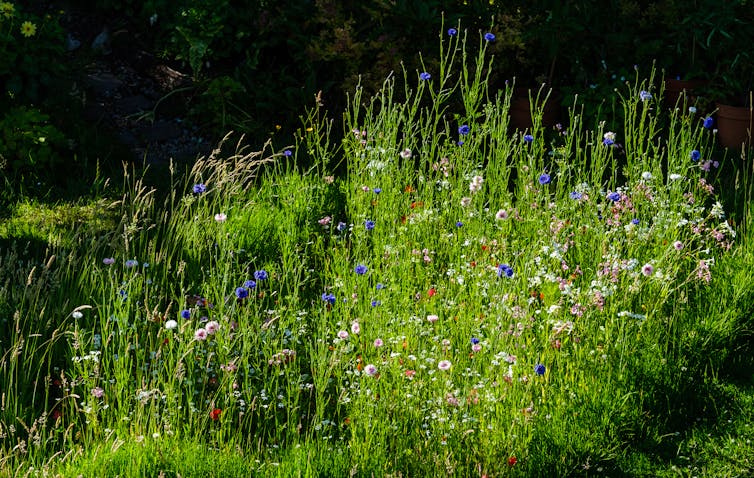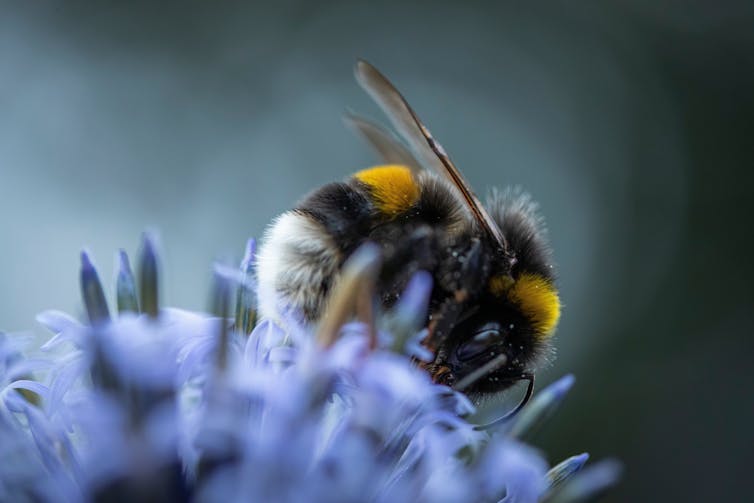
Over the last century, nearly all of the UK’s wildflower meadows have been destroyed by expanding farms, towns and cities. This loss of habitat has driven nature’s decline, according to research led by birds and nature conservation charity the RSPB.
As meadows and other wild spaces have disappeared in the UK and further afield, massive population crashes have followed: Europe has lost over 600 million birds since 1980, while insects have seen a 76% decline.
If you have a lawn, then you have a chance to help reverse this trend. No Mow May, a campaign led by plant conservation charity Plantlife, asks people to refrain from mowing the grass during May. With over 20 million gardens, the UK has an enormous resource with which to benefit wildlife.
Although a perfectly manicured lawn was traditionally perceived as the ideal British garden, concern for wildlife has forced a rethink. In recent years, wild and unruly gardens – including one inspired by a wetland transformed by beavers – have won best in show at the annual Chelsea Flower Show.
The No Mow May campaign is still in its infancy. What research has revealed about its effects so far, however, is encouraging.
Read more: Four steps to make your lawn a wildlife haven – from green desert to miniature rainforest
May there be flowers
No Mow May encourages people to leave their lawns wild for the whole month, letting flowers typically considered weeds to mature, flower and provide food for bees in the form of nectar and pollen. Fast-growing dandelions, cuckoo flower, daisies and buttercups are all likely to appear on lawns left to languish; you can enjoy the colours as wildlife enjoys the food.
That said, some people don’t like letting their entire lawn go wild. Fortunately, research has shown that leaving lots of small patches for wildflowers can still significantly benefit a variety of local pollinators. Small patches, adding up to no bigger than 20 square metres (about the size of a living room), can more than double the number of bees visiting your garden. This means you can maintain tidy areas of your garden while leaving a little bit for wildlife.

However, as you’re providing all this food for bees, using bug killer sprays will undo your hard work. Obviously insect sprays can harm bees, but even weedkiller can poison their stomachs.
Scientists believe wildlife-friendly gardens have huge potential to help urban wildlife, and recent studies have uncovered benefits to insect populations in particular. Research from a five-year study by Butterfly Conservation has shown a 93% increase in visits by butterflies to gardens participating in No Mow May. A survey of UK gardens found nearly half provide food for wild birds from feeders – we are already trying to encourage wildlife into our gardens, so No Mow May is just an extension of that.
The benefits go far beyond bees and butterflies: studies have shown increases in ground beetles (which eat common garden pests) and healthier earthworm populations amid better soil in less manicured lawns.
But, of course, everything can change on June 1.
A lean June for birds
Although common lawn flowers grow and bloom quickly, these flowers are done at the end of May and begin to spread seeds – providing a fantastic food source for birds such as goldfinches and sparrows. When mowing resumes, you destroy all this food the birds have been waiting for.
There’s another downside of resuming mowing after May. Bees are uniquely clever creatures that can learn where flowers are in their environment (your garden). This form of learning is called “flower constancy”, and is critical to how honeybees and bumblebees survive. When the wild patches are cut at the end of May, all the energy and effort the bees have put in to learning where to find these flowers is wasted.

The most useful gardens are those in which uncut patches become permanent. Leave small patches for wildlife and at the end of May, don’t mow them. A little corner of the garden set aside for wildlife can make a huge difference if we all do it.
As long-term patches become established, they “self-seed”, meaning the existing wildflowers become more dense and the patches look prettier with more colour and new plants appearing over subsequent years. Better looking patches become an encouragement to neighbours, nurturing people’s connection with nature and making them more likely to adopt wild gardens themselves.
An influential report published in 2010 continues to shape government policy on undoing decades of wildlife loss.
Its title, Making Space for Nature, was intended to incite sweeping changes to how landscapes are managed – but I have always felt this phrase is apt on the micro scale too. Everyone should make space for nature, where they can. No Mow May, and the enduring ethos it hopefully endows, is one way of doing so.

Don’t have time to read about climate change as much as you’d like?
Get a weekly roundup in your inbox instead. Every Wednesday, The Conversation’s environment editor writes Imagine, a short email that goes a little deeper into just one climate issue. Join the 30,000+ readers who’ve subscribed so far.
Philip Donkersley receives funding from EPSRC and AHRC.
This article was originally published on The Conversation. Read the original article.







